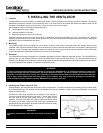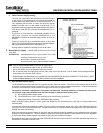
02/04 4034-102 Rev F 13
HRV200PLUS INSTALLATION INSTRUCTIONS
Note: When using the existing furnace duct work for air distribu-
tion, the furnace blower must be set to run continuously or inter-
locked with the HRV200PLUS. The interlock may be easily
achieved using the Furnace Interface Relay terminals on the
HRV200PLUS control board. These terminals interface directly with
the furnace control board using low voltage wiring. See wiring dia-
gram in Section L. WIRING for details.
b. Warmside Ducting Guidelines
To maximize air flow in the duct work system, all ducts should be kept short and have as few bends or elbows as possible. 45°
elbows are preferred to 90° elbows. Use Y tees instead of 90° tees whenever possible.
All duct joints must be fastened with screws, rivets or duct sealant and wrapped with a quality duct tape to prevent leakage. We
recommend aluminum foil duct tape or tape and mastic.
Galvanized ducting from the HRV200PLUS to the living areas in the house is recommended whenever possible, although
flexible duct can be used in moderation if necessary.
The main supply and return lines to and from the HRV200PLUS must be 6 (150mm) minimum. Branch lines to the individual
rooms may be as small as 4 (100mm), but 5 (125mm) lines are preferred.
All ducts running through attics, crawl spaces or other unconditioned spaces must be sealed and insulated to code.
c. Dampers and Grilles
The use of balancing dampers and/or adjustable grilles to balance the flow rates into various rooms is recommended.
We recommend the use of high mounted wall returns with grilles. The exhaust air duct from the kitchen should never be
connected to a range hood. Instead, the exhaust grille should be mounted high on the wall at least 4 (1.2m) horizontally away
from the stove. A flip-up, 6 x 10 (150 x 250mm) rectangular kitchen grille with removable grease filter is recommended.
SeeFigure3.
Dampers should be located just prior to the HRV200PLUS to balance the stale air exhausted out of the house with a fresh air
supply entering the house.
CAUTION:
Check temperature specifications of hoods and
grilles before installation to avoid possible damage
to them by the flow of warm/hot air. Hoods and grilles
should be rated for use at or above 200°F.
Figure 3
Recommended Exhaust Grille for Kitchen


















